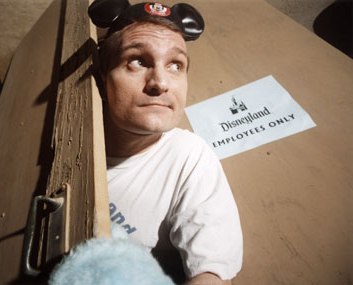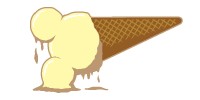Warm and fuzzy: `Working for the Mouse’ evolves
A man of character, Trevor Allen decided to put his character life behind him.
Having detailed what it's really like to work as a costumed character in Disneyland in his popular solo show Working for the Mouse, Allen made a conscious decision to focus on his burgeoning career as a playwright. Mouse, under the direction of Kent Nicholson, had a great run at Berkeley's Impact Theatre (and a transfer to the EXIT in San Francisco), but the time had come to hang up the ears and write.
He had abundant projects, including one about Albert Einstein with found-object puppeteer Liebe Wetzel, another about artificial intelligence that the Magic Theatre picked up for its New Media Festival and yet another assignment to write something for Playground.
The resulting plays, One Stone, The Nutshell and Tenders in the Fog respectively, were all well received but only Tenders ended up being produced (by San Jose Stage Company). Then came Zoo Logic and Lolita Road Trip, two more projects that generated readings and interest but, so far, no actual productions.
Rather than do the writerly thing and revel in despondency, San Francisco resident Allen headed back to the Magic Kingdom. For just a few jam-packed performances in the summer of 2005, he resurrected Working for the Mouse at Bus Barn Theatre in Los Altos. For those few shows, he traveled back in time to age 17. He was an acting student at UCLA (studying with "The Brady Bunch's" Robert Reed, no less) and worked at Disneyland, first as Pluto, then as Capt. Hook's first mate, Mr. Smee, then as various characters including Eeyore (from Winnie the Pooh), Friar Tuck (from Robin Hood) and Gideon (the mute cat from Pinocchio). He graduated to "face work," meaning he wasn't enclosed in plastic and fur, with the Mad Hatter from Alice in Wonderland and actually got to utilize his improvisational skills when interacting with park guests.
A friend of Allen's from Los Angeles encouraged him to come do Mouse at a small North Hollywood theater. "It'd sell out!" the friend said.
And Allen wondered, if he took the show to LA, if that is exactly what he'd be doing: selling out.
"I had considered taking the show to the Fringe Festival in Edinburgh, then I had to think about LA, and then I thought, `Do I really want to be the guy who does funny voices and plays Pluto and the Mad Hatter?'" Allen says over lunch at, yes it's true, Pluto's.
That's when Allen's wife, Theatre Bay Area magazine editor Karen McKevitt, said it was time to do something serious about Working for the Mouse. She pointed out that when he talked about his four years as a character in Disneyland, he always had fresh stories to tell that never made their way into the show. She landed on a solution: Turn the stories into a book utilizing the factual but entertaining writing style known as creative nonfiction.
Allen is currently hard at work on that book. Until he finds a publisher brave enough to weather the Disney waters, that book-in-progress is also a blog: www.workingforthemouse.com. This is the 21st century, after all.
"As a performer, you get immediate response from an audience," Allen says. "You know when a story or a line works or doesn't work. The same is true with the blog. You put it out there yourself – you don't have to wait for someone to publish you. There's no barrier between the artist and the audience anymore. I hear immediately from people, some who love Disney, some who hate it."
The blog belies Allen's theatrical roots because there's a whole lot more available than chapters (called "mouse droppings") of the upcoming book. There's performance video and, to the author's great delight, podcasts in which the actor gets to exercise his expertise with voice over narration.
"Now that I'm not writing for performance, I'm able to get into the heads of the other characters more," he says. "Then turning that into audio is great fun."
Working for the Mouse is, in many ways, Allen's coming-of-age story. He was a 17-year-old San Jose native, somewhat naïve, getting a fast education about life in the real world. Backstage and after hours at Disneyland was sex, drugs and rock 'n' roll, but it was also more than that.
"It was a real education," Allen says. "What I saw there, backstage and during work hours, was tragic, raw, funny and sad. From inside the costumes, you saw a parade of human tragedy going by in the guests. At a certain point after I had left the Disney bubble, it occurred to me, `Why is no one telling this story?'"
One answer is easy: because Disney will sue your pants off. They'll cease and desist you so quickly you won't know your Mickey from your Mouse.
"I've always thought that in the world of theater, the more controversial the better," Allen says. "Freedom of speech is supposed to allow for that. But Big business has co-opted the place of religion and government in dictating what you can or can't say. I'm of the school, as a playwright, a performer or a writer, you have to tell stories that haven't been told, and that's what I'm trying to do."
So far, response to the blog has been good. There's even been some interest in reviving the one-man show, which Allen says he'd be happy to do, especially since working on the Mouse has given him new insights.
"This has been a process of rediscovery," he says. "The arc of the show would likely remain unchanged, but I think I'm finding some other stories with some different resonance."
Here's a taste of Working for the Mouse, the show and the Web site:
Visit www.workingforthemouse.com

